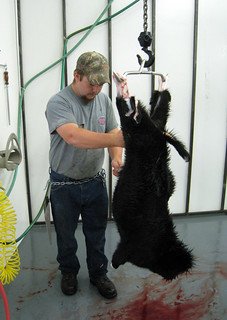In the United States, there are four levels of meat inspection: federal (USDA), state, custom-exempt, and personal exemption (on-farm slaughter).
Federal is the "highest" level of inspection. The meat from animals slaughtered in a federally-inspected plant can be sold without restrictions, so long as the meat is properly labeled. Though state-inspection must be "at least equal to" federal inspection, the meat from animals slaughtered in a state-inspected facility is usually limited to sales within the state of slaughter.
Only 27 states have state meat inspection programs. Custom-exempt slaughter is exempt from continuous inspection. The carcasses and meat from animals slaughtered in a custom-exempt plant are stamped "not for resale" and returned to the owner. Federal and state regulations provide a personal exemption. The personal exemption allows a farmer to slaughter an animal (of his own raising).
States interpret USDA's "personal exemption" differently. Most states take a very strict interpretation and consider the owner of the animal to only be the person who actually raised it. In New York, the owner of the animal is considered to be the owner when they purchase it. The state of Vermont recently passed a law that will allow the on-farm slaughter of up to 25 sheep or no more than 3,500 lbs. (live weight) of any combination of livestock.
Because meat inspection laws vary by state and sometimes county, it is essential that farmers/producers know the laws in their state and how they are interpreted.
Read full article at http://www.sheepandgoat.com/articles/onfarmslaughter.html.
 |
| Custom-exempt slaughter |
Only 27 states have state meat inspection programs. Custom-exempt slaughter is exempt from continuous inspection. The carcasses and meat from animals slaughtered in a custom-exempt plant are stamped "not for resale" and returned to the owner. Federal and state regulations provide a personal exemption. The personal exemption allows a farmer to slaughter an animal (of his own raising).
States interpret USDA's "personal exemption" differently. Most states take a very strict interpretation and consider the owner of the animal to only be the person who actually raised it. In New York, the owner of the animal is considered to be the owner when they purchase it. The state of Vermont recently passed a law that will allow the on-farm slaughter of up to 25 sheep or no more than 3,500 lbs. (live weight) of any combination of livestock.
Because meat inspection laws vary by state and sometimes county, it is essential that farmers/producers know the laws in their state and how they are interpreted.
Read full article at http://www.sheepandgoat.com/articles/onfarmslaughter.html.

No comments:
Post a Comment